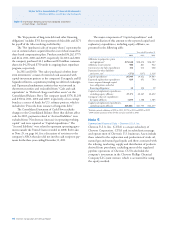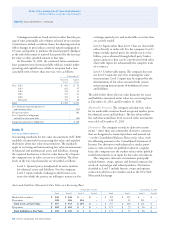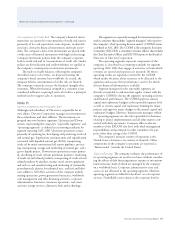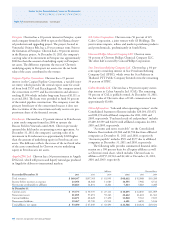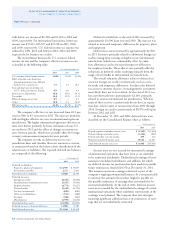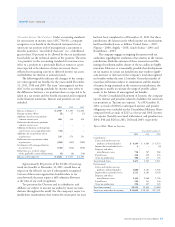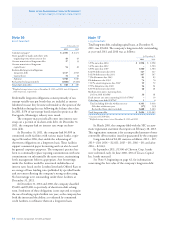Chevron 2011 Annual Report Download - page 52
Download and view the complete annual report
Please find page 52 of the 2011 Chevron annual report below. You can navigate through the pages in the report by either clicking on the pages listed below, or by using the keyword search tool below to find specific information within the annual report.
50 Chevron Corporation 2011 Annual Report
Note 14 Litigation – Continued
Notes to the Consolidated Financial Statements
Millions of dollars, except per-share amounts
remaining environmental damage reects Petroecuador’s fail-
ure to timely fulll its legal obligations and Petroecuador’s
further conduct since assuming full control over the
operations.
In 2008, a mining engineer appointed by the court to
identify and determine the cause of environmental damage,
and to specify steps needed to remediate it, issued a report
recommending that the court assess $18,900, which would,
according to the engineer, provide nancial compensation for
purported damages, including wrongful death claims, and pay
for, among other items, environmental remediation, health
care systems and additional infrastructure for Petro ecuador.
e engineer’s report also asserted that an additional $8,400
could be assessed against Chevron for unjust enrichment. In
2009, following the disclosure by Chevron of evidence that
the judge participated in meetings in which businesspeople
and individuals holding themselves out as government ocials
discussed the case and its likely outcome, the judge presiding
over the case was recused. In 2010, Chevron moved to strike
the mining engineer’s report and to dismiss the case based on
evidence obtained through discovery in the United States
indicating that the report was prepared by consultants for the
plaintis before being presented as the mining engineer’s
independent and impartial work and showing further evi-
dence of misconduct. In August 2010, the judge issued an
order stating that he was not bound by the mining engineer’s
report and requiring the parties to provide their positions on
damages within 45 days. Chevron subsequently petitioned for
recusal of the judge, claiming that he had disregarded evi-
dence of fraud and misconduct and that he had failed to rule
on a number of motions within the statutory time
requirement.
In September 2010, Chevron submitted its position on
damages, asserting that no amount should be assessed against
it. e plaintis’ submission, which relied in part on the min-
ing engineer’s report, took the position that damages are
between approximately $16,000 and $76,000 and that unjust
enrichment should be assessed in an amount between approxi-
mately $5,000 and $38,000. e next day, the judge issued an
order closing the evidentiary phase of the case and notifying
the parties that he had requested the case le so that he could
prepare a judgment. Chevron petitioned to have that order
declared a nullity in light of Chevron’s prior recusal petition,
and because procedural and evidentiary matters remained
unresolved. In October 2010, Chevron’s motion to recuse the
judge was granted. A new judge took charge of the case and
revoked the prior judge’s order closing the evidentiary phase of
the case. On December 17, 2010, the judge issued an order
closing the evidentiary phase of the case and notifying the
parties that he had requested the case le so that he could pre-
pare a judgment.
On February 14, 2011, the provincial court in Lago
Agrio rendered an adverse judgment in the case. e court
rejected Chevron’s defenses to the extent the court addressed
them in its opinion. e judgment assessed approximately
$8,600 in damages and approximately $900 as an award for
the plaintis’ representatives. It also assessed an additional
amount of approximately $8,600 in punitive damages unless
the company issued a public apology within 15 days of the
judgment, which Chevron did not do. On February 17, 2011,
the plaintis appealed the judgment, seeking increased dam-
ages, and on March 11, 2011, Chevron appealed the judgment
seeking to have the judgment nullied. On January 3, 2012,
an appellate panel in the provincial court armed the Febru-
ary 14, 2011, decision and ordered that Chevron pay
additional attorneys’ fees in the amount of “.10% of the values
that are derived from the decisional act of this judgment.” e
plaintis led a petition to clarify and amplify the appellate
decision on January 6, 2012, and the court issued a ruling in
response on January 13, 2012, purporting to clarify and
amplify its January 3, 2012 ruling, which included clarica-
tion that the deadline for the company to issue a public
apology to avoid the additional amount of approximately
$8,600 in punitive damages was within 15 days of the
clarication ruling, or February 3, 2012. Chevron did not
issue an apology because doing so might be mischaracterized
as an admission of liability and would be contrary to facts and
evidence submitted at trial. On January 20, 2012, Chevron
appealed (called a petition for cassation) the appellate panel’s
decision to Ecuador’s National Court of Justice. As part of the
appeal, Chevron requested the suspension of any requirement
that Chevron post a bond to prevent enforcement under
Ecuadorian law of the judgment during the cassation appeal.
On February 17, 2012, the appellate panel of the provincial
court admitted Chevron’s cassation appeal in a procedural
step necessary for the National Court of Justice to hear the
appeal. e provincial court appellate panel denied Chevron’s
request for suspension of the requirement that Chevron post a
bond and stated that it would not comply with the rst
Interim Award of the international arbitration tribunal dis-
cussed below. Chevron continues to believe the provincial
court’s judgment is illegitimate and unenforceable in Ecuador,
the United States and other countries. e company also
believes the judgment is the product of fraud, and contrary to
the legitimate scientic evidence. Chevron cannot predict the
timing or ultimate outcome of the appeals process in Ecuador.
Chevron will continue a vigorous defense of any imposition of
liability. Chevron has no assets in Ecuador and the Lago
Agrio plaintis’ lawyers have stated in press releases and
through other media that they will seek to enforce the Ecua-
dorian judgment in various countries and otherwise disrupt
Chevron’s operations. Chevron expects to contest and defend
against any such actions.


